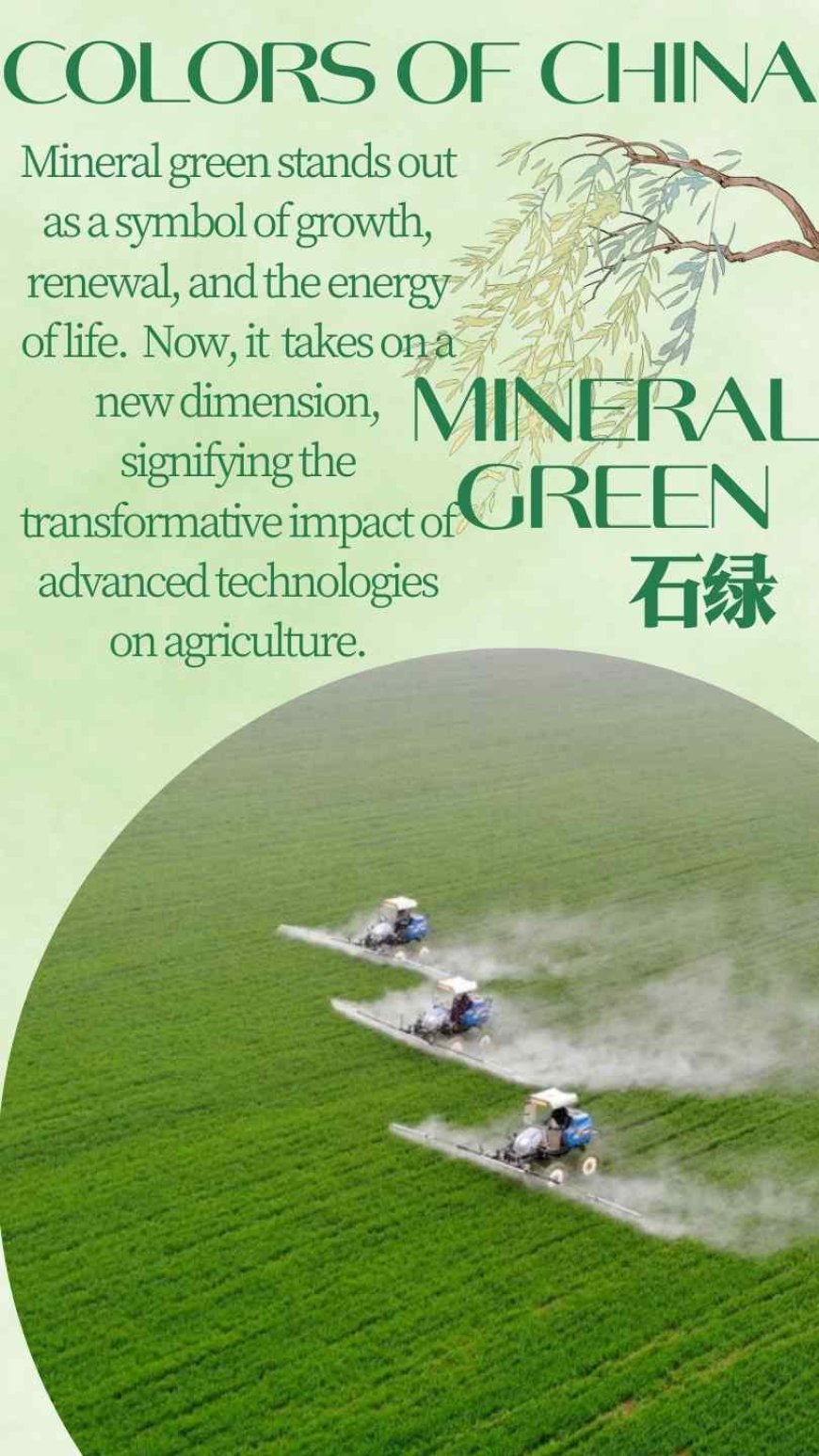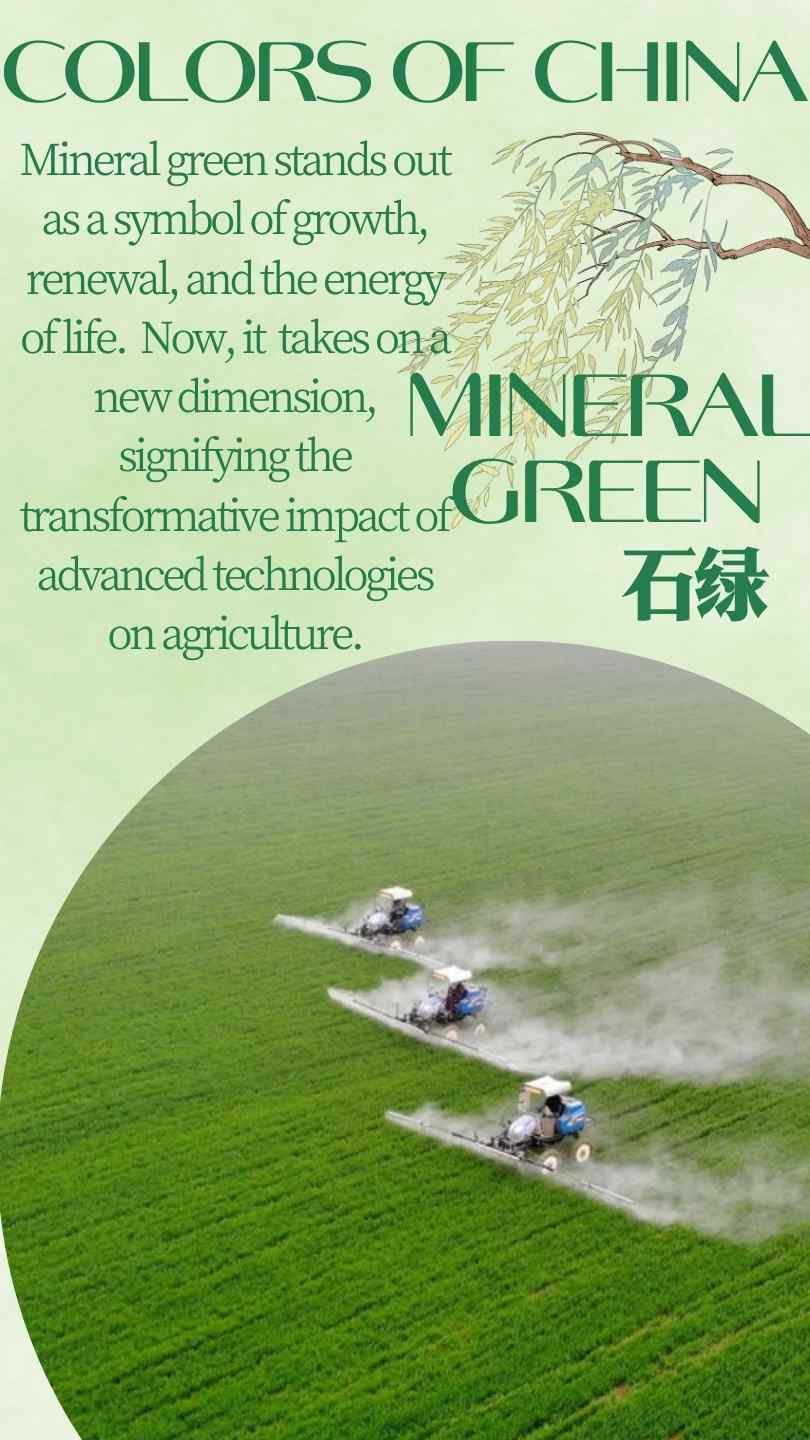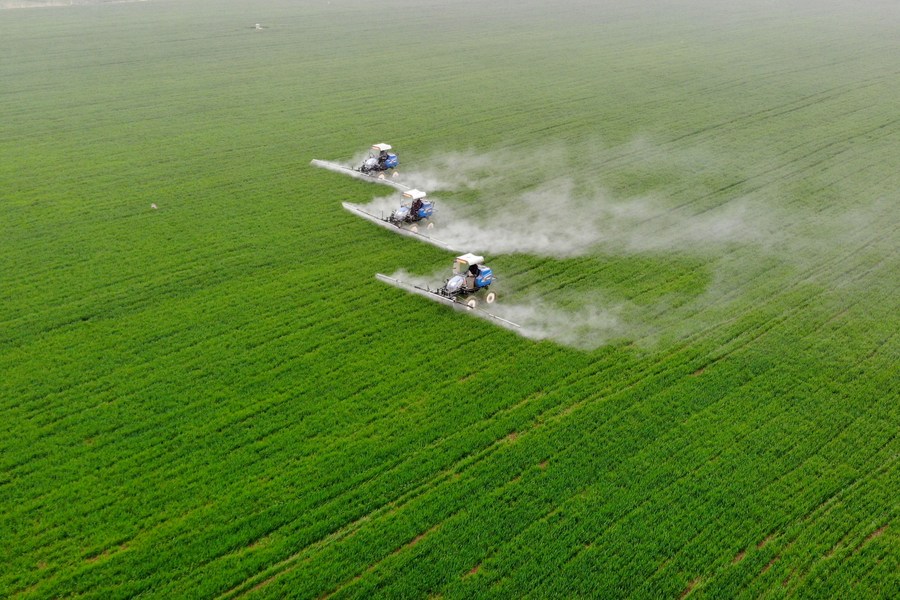In China’s countryside, mineral green signifies agricultural innovation
In China's countryside, mineral green signifies agricultural innovation People's Daily

The Significance of Mineral Green in Chinese Agriculture

In traditional Chinese culture, mineral green symbolizes growth, renewal, and life’s energy. Historically linked to spring’s rejuvenating qualities, this color captures the essence of natural revival. Today, the color is taking on new meaning, representing the intersection of traditional agricultural practices and modern technological innovation.
The Historical Symbolism of Mineral Green
Throughout Chinese history, mineral green has been a symbol of vitality and prosperity, reflecting the agricultural cycle’s rhythms of hope, renewal, and abundant harvests — core elements of China’s cultural heritage. It’s a color that has long embodied natural fertility and the promise of new beginnings each spring.

Photo shows rice seedlings in a greenhouse in Shangcheng county, central China’s Henan Province. (Photo/Hong Xiaoyan)
Mineral Green as a Symbol of Technological Advancement
In modern times, mineral green has taken on a new meaning, representing the transformative effect of advanced technologies on agriculture. As China begins spring farming — a crucial time for grain production — the landscape, covered in mineral green, has become a living picture that shows the combination of natural growth and technological progress. This change represents a significant shift, where mineral green symbolizes not only fertility but also innovation, marking a new phase in agricultural development.
The transformation of the agricultural sector is vividly showcased through the use of cutting-edge technologies that increase efficiency and productivity. This move toward innovation is represented by the bright shades of mineral green across the Chinese countryside, marking a shift from traditional methods to a smarter, more precise, and sustainable agricultural model.

A farmer uses unmanned vehicles to spray pesticide over fields in Huagang town, Feixi county, Hefei, east China’s Anhui Province, Feb. 23, 2021. (Xinhua/Liu Junxi)
Technological Advancements in Chinese Agriculture
For instance, in Xiaolou Town, located in the southern part of China’s Guangdong Province, seedling centers have adopted digital systems that monitor environmental conditions in real-time, greatly improving the ability to respond quickly to any changes.
Similarly, in Malianzhuang Town in eastern Shandong province, drones equipped with advanced cameras collect essential data. This information is crucial for creating detailed management maps for spring farming, allowing for the development of customized agricultural strategies. These technological advancements are redefining traditional farming practices, combining centuries-old agricultural knowledge with the latest innovations.
The Future of Chinese Agriculture
As a result, mineral green has become a symbol of the bright future of agriculture. In this future, innovation leads the way for smarter, more efficient, and more sustainable farming practices. This color now represents China’s commitment to combining its rich agricultural heritage with the breakthroughs of the modern world, signaling a future where tradition and technology come together in the vibrant and ever-changing landscape of Chinese agriculture.
(Web editor: Tian Yi, Wu Chengliang)
SDGs, Targets, and Indicators
| SDGs | Targets | Indicators |
|---|---|---|
| SDG 2: Zero Hunger | 2.4: By 2030, ensure sustainable food production systems and implement resilient agricultural practices that increase productivity and production, that help maintain ecosystems, that strengthen capacity for adaptation to climate change, extreme weather, drought, flooding, and other disasters, and that progressively improve land and soil quality. | – Use of advanced technologies in agriculture – Adoption of digital systems to monitor environmental conditions – Use of drones to collect essential data for agricultural strategies |
| SDG 9: Industry, Innovation, and Infrastructure | 9.5: Enhance scientific research, upgrade the technological capabilities of industrial sectors in all countries, in particular developing countries, including, by 2030, encouraging innovation and substantially increasing the number of research and development workers per 1 million people and public and private research and development spending. | – Adoption of advanced technologies in agriculture – Use of drones equipped with advanced cameras for data collection |
1. Which SDGs are addressed or connected to the issues highlighted in the article?
SDG 2: Zero Hunger
The article highlights the transformation of the agricultural sector in China through the use of advanced technologies. This connects to SDG 2, which aims to ensure sustainable food production systems and implement resilient agricultural practices.
SDG 9: Industry, Innovation, and Infrastructure
The article emphasizes the role of technological innovation in agriculture, showcasing the adoption of digital systems and drones equipped with advanced cameras. This aligns with SDG 9, which focuses on enhancing scientific research and encouraging innovation in various sectors, including agriculture.
2. What specific targets under those SDGs can be identified based on the article’s content?
Target 2.4: By 2030, ensure sustainable food production systems and implement resilient agricultural practices that increase productivity and production, that help maintain ecosystems, that strengthen capacity for adaptation to climate change, extreme weather, drought, flooding, and other disasters, and that progressively improve land and soil quality.
The article highlights the use of advanced technologies, such as digital systems and drones, to improve agricultural practices and increase productivity. These advancements contribute to the target of implementing resilient agricultural practices and enhancing food production systems.
Target 9.5: Enhance scientific research, upgrade the technological capabilities of industrial sectors in all countries, in particular developing countries, including, by 2030, encouraging innovation and substantially increasing the number of research and development workers per 1 million people and public and private research and development spending.
The article showcases the adoption of advanced technologies in agriculture, indicating an enhancement of technological capabilities in the sector. The use of drones equipped with advanced cameras for data collection also reflects the encouragement of innovation. These actions contribute to the target of upgrading technological capabilities and increasing research and development efforts.
3. Are there any indicators mentioned or implied in the article that can be used to measure progress towards the identified targets?
Yes, the article mentions several indicators that can be used to measure progress towards the identified targets:
- Use of advanced technologies in agriculture
- Adoption of digital systems to monitor environmental conditions
- Use of drones to collect essential data for agricultural strategies
These indicators reflect the implementation of resilient agricultural practices, technological advancements, and innovation in the agricultural sector.
4. SDGs, Targets, and Indicators
| SDGs | Targets | Indicators |
|---|---|---|
| SDG 2: Zero Hunger | 2.4: By 2030, ensure sustainable food production systems and implement resilient agricultural practices that increase productivity and production, that help maintain ecosystems, that strengthen capacity for adaptation to climate change, extreme weather, drought, flooding, and other disasters, and that progressively improve land and soil quality. | – Use of advanced technologies in agriculture – Adoption of digital systems to monitor environmental conditions – Use of drones to collect essential data for agricultural strategies |
| SDG 9: Industry, Innovation, and Infrastructure | 9.5: Enhance scientific research, upgrade the technological capabilities of industrial sectors in all countries, in particular developing countries, including, by 2030, encouraging innovation and substantially increasing the number of research and development workers per 1 million people and public and private research and development spending. | – Adoption of advanced technologies in agriculture – Use of drones equipped with advanced cameras for data collection |
Behold! This splendid article springs forth from the wellspring of knowledge, shaped by a wondrous proprietary AI technology that delved into a vast ocean of data, illuminating the path towards the Sustainable Development Goals. Remember that all rights are reserved by SDG Investors LLC, empowering us to champion progress together.
Source: en.people.cn

Join us, as fellow seekers of change, on a transformative journey at https://sdgtalks.ai/welcome, where you can become a member and actively contribute to shaping a brighter future.







